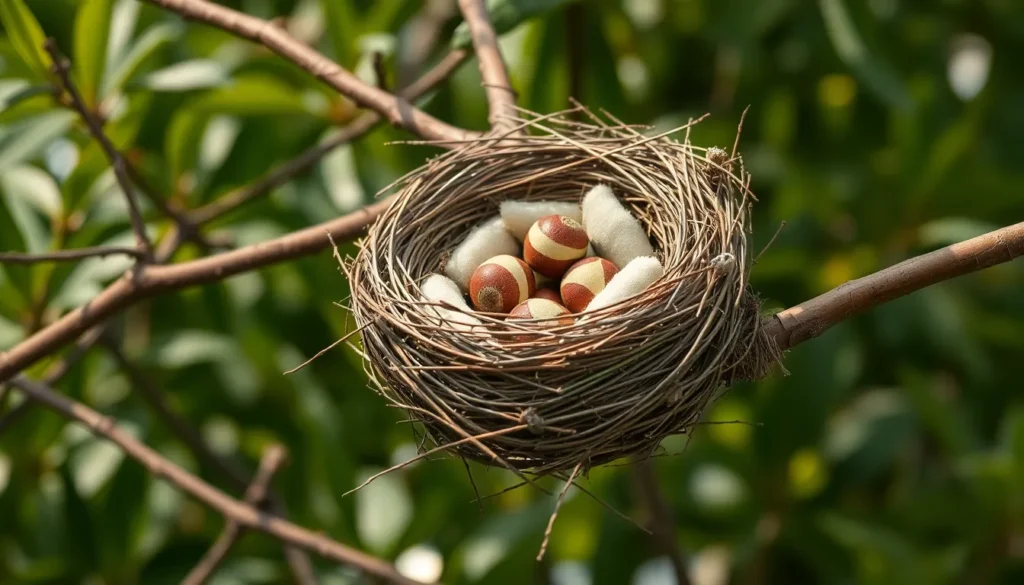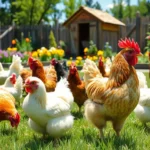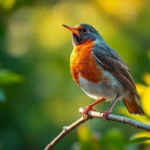Ever wondered how birds create those intricate architectural marvels we call nests? We’ve all spotted these fascinating structures tucked away in trees or perched on ledges but rarely stop to appreciate the incredible engineering behind them.
Bird nests represent some of nature’s most impressive construction projects. From the tiny hummingbird’s cup-shaped home to the massive eagle’s fortress these feathered architects use everything from twigs and mud to spider silk and even human-made materials to build their perfect sanctuary.
We’re about to dive deep into the remarkable industry of bird nest construction exploring the different types materials used and the incredible techniques various species have mastered over millions of years of evolution. You’ll discover why location matters how weather influences design and what these structures reveal about avian intelligence and survival instincts.
What Is a Bird Nest and Why Do Birds Build Them?
A bird nest serves as a carefully constructed shelter where birds lay eggs, incubate them, and raise their young. These structures function as temporary homes that protect developing offspring from predators, weather conditions, and environmental hazards during the most vulnerable stages of their lives.
Birds build nests primarily for reproductive success and species survival. The construction process occurs during breeding season when hormonal changes trigger nesting behaviors in both male and female birds. Most species invest important time and energy into nest building because successful reproduction depends on creating a safe environment for eggs and chicks.
Primary Functions of Bird Nests
Bird nests serve multiple essential purposes beyond simple egg storage:
- Protection from harsh weather including rain, wind, and temperature extremes
- Camouflage that conceals eggs and young birds from potential threats
- Insulation that maintains optimal temperature for egg development and chick survival
- Structural support that prevents eggs from rolling away or breaking
- Territorial marking that establishes breeding boundaries for mating pairs
Biological Drivers Behind Nest Construction
Seasonal hormonal fluctuations trigger nest building behaviors in birds across different species. Testosterone levels in males and estrogen levels in females increase during breeding season, activating the instinctual drive to construct nests. These hormonal changes also influence mate selection, with many female birds choosing partners based on the quality and location of their nests.
Environmental factors play crucial roles in determining when birds begin nest construction. Temperature increases, daylight extension, and food availability signal optimal breeding conditions. Birds typically synchronize their nesting activities with peak resource availability to ensure adequate nutrition for growing chicks.
Genetic programming guides exact construction techniques that each species inherits through evolutionary development. Young birds observe and learn from their parents, refining their nest building skills through practice and experience. This combination of instinct and learning creates the remarkable diversity we observe in nest architecture across different bird species.
Types of Bird Nests
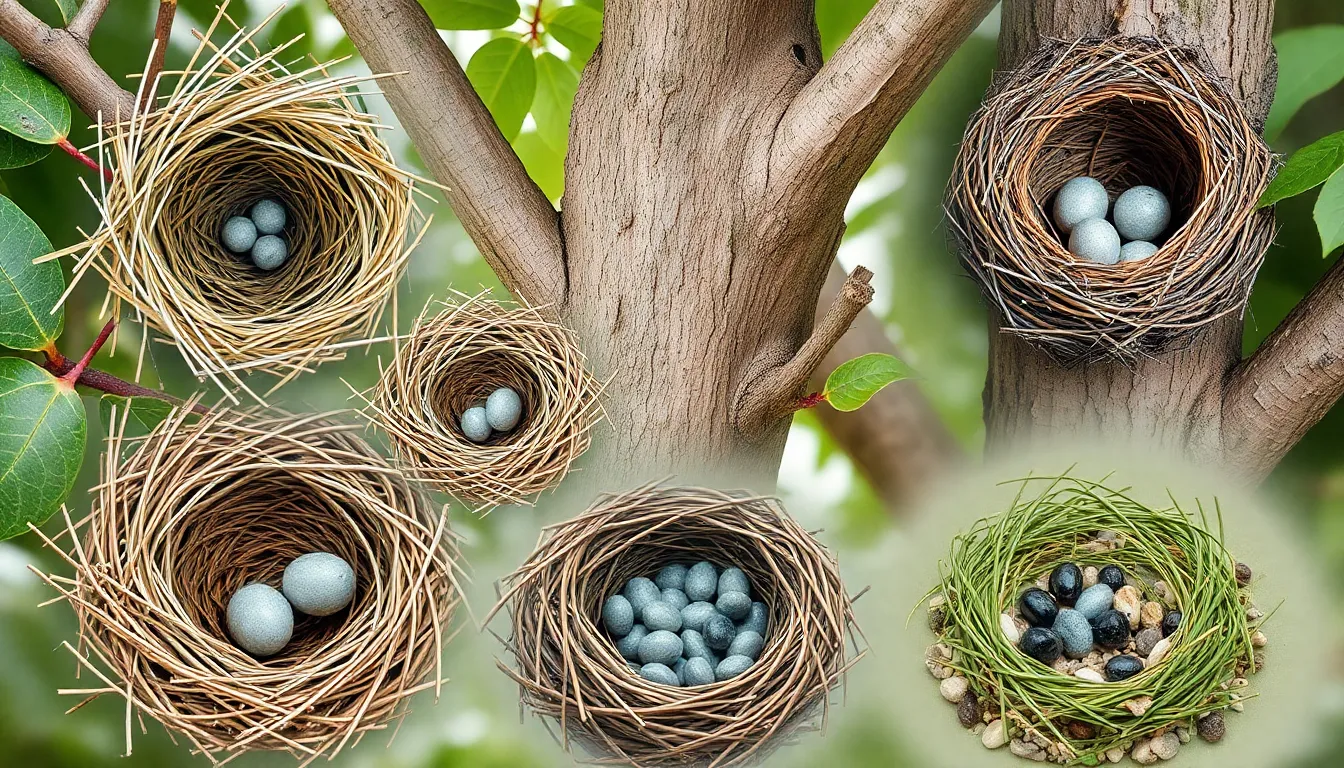
Bird species create four primary nest categories, each adapted to exact environmental conditions and survival strategies. We observe these distinct architectural approaches across thousands of avian species worldwide.
Cup Nests
Cup nests represent the most common nest architecture among songbirds and small perching species. Robins construct these bowl-shaped structures using mud, grass, and twigs, creating secure cradles that prevent eggs from rolling out. The rounded design provides optimal protection for developing chicks while allowing parents easy access for feeding.
Warblers weave intricate cup nests using fine grasses and spider silk, often suspending them between forked branches 3-15 feet above ground. Cardinals build their cup nests in dense shrubs, incorporating leaves and bark strips for camouflage. These structures typically measure 3-4 inches in diameter and feature walls that curve inward to create the characteristic bowl shape.
Platform Nests
Platform nests consist of flat, horizontal structures that provide stable foundations for larger bird species. Eagles construct massive platform nests using thick branches and sticks, with some reaching 6 feet in diameter and weighing over 2,000 pounds. These structures can accommodate multiple breeding seasons, with birds adding materials annually.
Herons build platform nests in tall trees near water sources, creating communities called rookeries where dozens of nests cluster together. Ospreys construct their platform nests on high structures like cell towers and dead trees, using fish bones and seaweed alongside traditional materials. The flat design distributes weight evenly and accommodates the large size of parent birds and their offspring.
Cavity Nests
Cavity nests offer maximum protection by utilizing enclosed spaces within trees, cliffs, or artificial structures. Woodpeckers excavate their own cavities, creating perfectly sized chambers with entrance holes typically 1.5-2.5 inches in diameter. The enclosed design provides excellent insulation and shields occupants from predators and weather extremes.
Bluebirds nest in natural tree cavities or specially designed nest boxes, preferring openings that face away from prevailing winds. Owls often commandeer abandoned woodpecker holes or use natural tree hollows, with screech owls selecting cavities 8-30 feet above ground. These protected environments maintain stable temperatures and humidity levels crucial for successful incubation.
Ground Nests
Ground nests demonstrate remarkable camouflage adaptation, with birds creating shallow depressions lined with local materials. Killdeer construct simple scrapes in gravel or short grass, using broken eggshells and pebbles that perfectly match surrounding terrain. The minimal construction allows for quick abandonment if predators approach.
Meadowlarks weave dome-shaped ground nests with grass tunnels leading to hidden entrances, creating structures nearly invisible from above. Quail build ground nests beneath dense vegetation, lining shallow depressions with dried grass and feathers. These low-profile nests rely on concealment rather than elevation for protection, with parents developing elaborate distraction displays to lead threats away from nest sites.
Bird Nest Construction Materials and Techniques
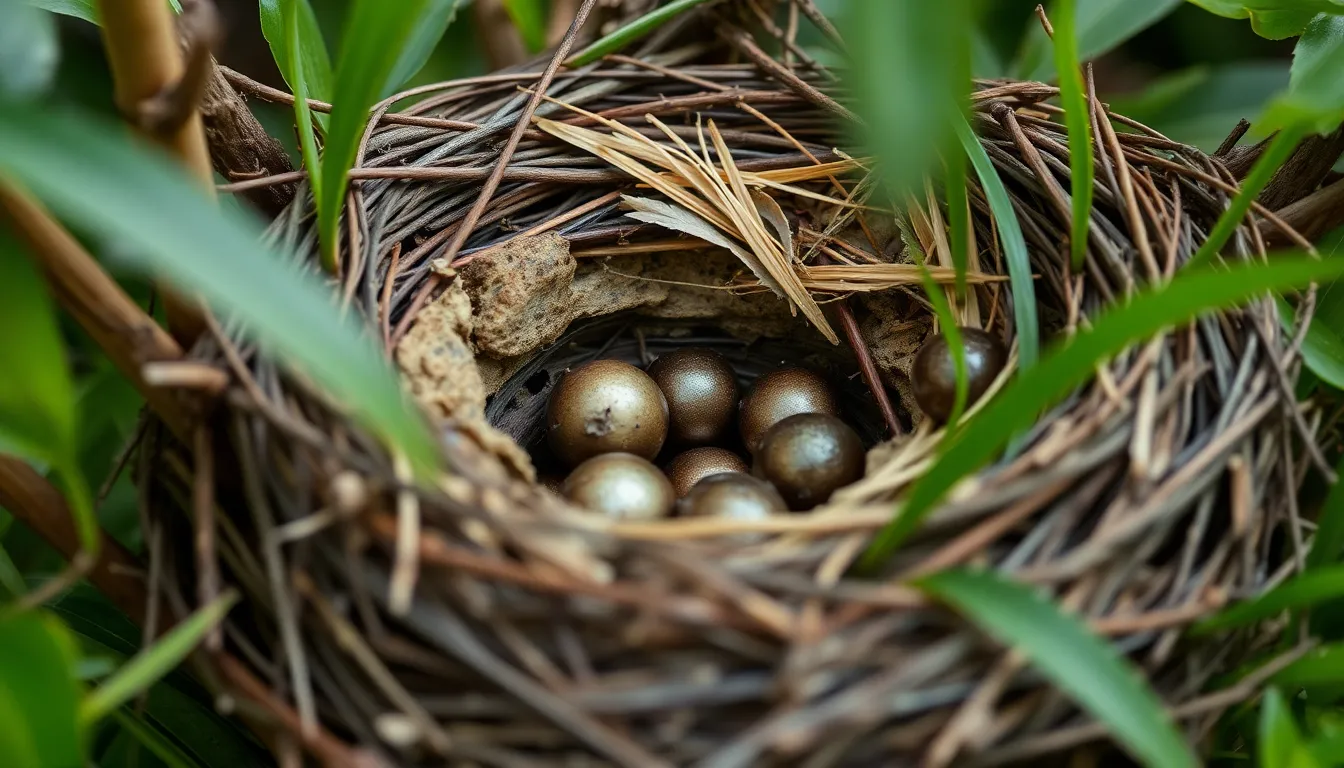
Bird nest construction showcases nature’s most sophisticated architectural processes, combining instinctive knowledge with environmental adaptation. We observe remarkable diversity in both materials selection and building methods across different species.
Natural Materials Used
Birds demonstrate exceptional resourcefulness when selecting construction materials, often combining multiple elements to create structurally sound homes. Twigs and branches form the primary framework for most nest types, with birds choosing exact diameters ranging from 2-15mm depending on nest size requirements.
Plant fibers provide essential binding properties, including:
- Grass stems and leaves for flexibility
- Moss for moisture retention and insulation
- Bark strips for waterproofing
- Root systems for structural reinforcement
Mud and clay serve as natural cement in species like robins and swallows, creating walls up to 3cm thick that harden into permanent structures. We find that birds often mix saliva with mud to enhance adhesive properties, particularly in cliff swallow colonies where thousands of nests attach to vertical surfaces.
Soft materials line interior spaces for comfort and insulation, featuring animal hair, feathers, cotton fibers, and spider silk. Spider webs offer unique advantages with their elasticity and strength, allowing nests to expand as chicks grow while maintaining structural integrity.
| Material Type | Primary Function | Common Species | Typical Quantity |
|---|---|---|---|
| Twigs | Framework | Robins, Cardinals | 50-200 pieces |
| Mud | Binding/Walls | Swallows, Thrushes | 1-3 cups |
| Grass | Lining | Sparrows, Finches | 20-40 stems |
| Feathers | Insulation | Chickadees, Wrens | 10-50 pieces |
Construction Methods
Bird nest construction follows distinct phases that maximize efficiency and structural stability. Site preparation begins with clearing debris and testing branch flexibility, ensuring the chosen location supports the anticipated weight of eggs, chicks, and adult birds.
Foundation laying establishes the nest’s base structure through systematic material placement. Birds weave twigs in crisscross patterns, creating interlocking frameworks that distribute weight evenly across supporting branches. We observe that experienced builders complete this phase 40% faster than first-time nesters.
Wall construction varies significantly among species, with cup nest builders using circular motions to shape interior spaces. Birds press their bodies against emerging walls to create perfectly fitted dimensions, typically measuring 7-12cm in diameter for songbird species. Platform nest builders focus on horizontal expansion, adding layers until achieving desired thickness of 15-30cm.
Lining installation represents the final construction phase, where birds select softest available materials for direct egg contact. They arrange fibers in exact patterns that promote air circulation while maintaining consistent temperature zones within 2-3°C ranges.
Quality control occurs throughout construction, with birds regularly testing structural integrity by applying pressure and adjusting loose materials. Mated pairs often work in shifts, with one bird gathering materials while the other continues assembly, reducing total construction time from 2-3 weeks to 7-10 days in optimal conditions.
Where Birds Choose to Build Their Nests
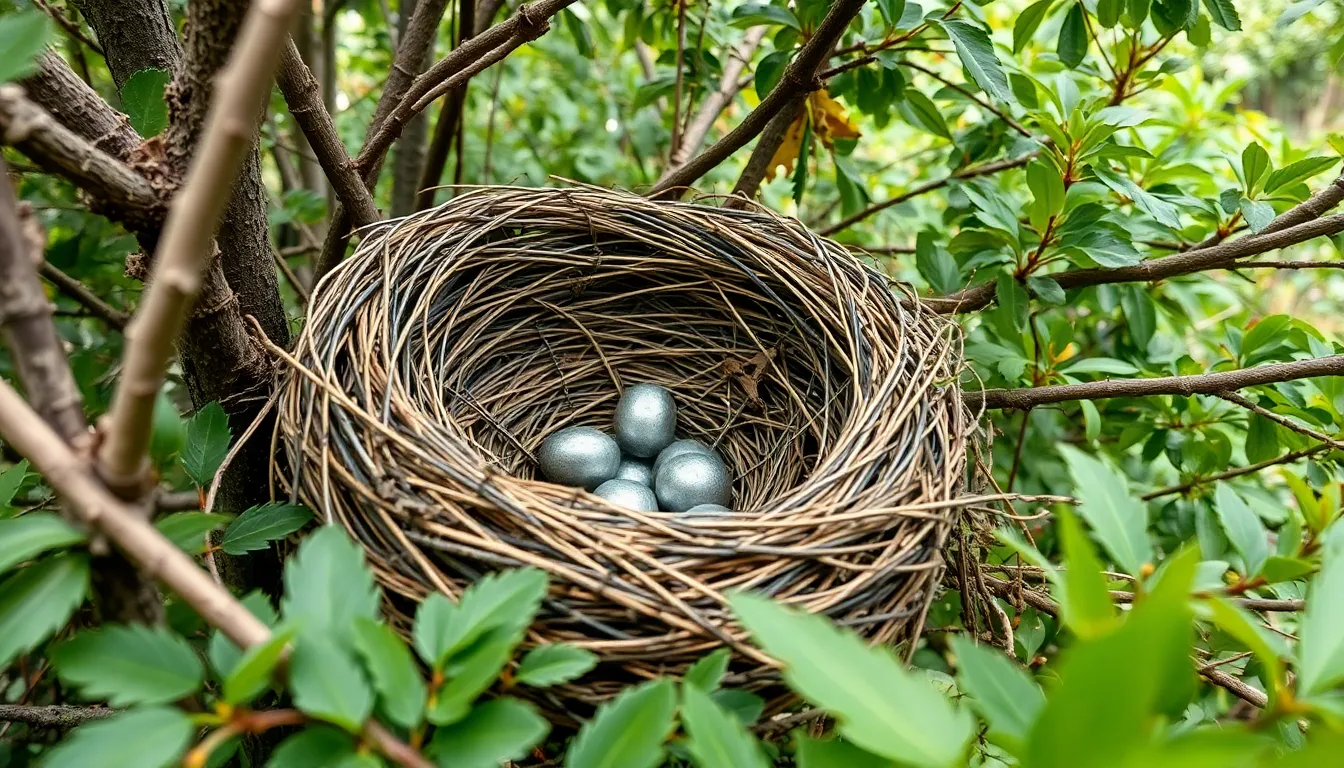
Birds select nesting locations based on three critical factors: protection from predators, environmental conditions, and resource availability. Strategic placement determines reproductive success more than any other single factor in avian breeding cycles.
Height and Elevation Preferences
Songbirds typically construct nests 3-12 feet above ground in dense vegetation to balance predator avoidance with accessibility. Eagles and hawks position their platform nests 50-150 feet high in sturdy trees, utilizing thermal updrafts for efficient hunting flights. Ground-nesting species like plovers and larks choose open areas with clear sightlines extending 100+ yards in multiple directions.
Habitat Selection Patterns
Forest-dwelling birds favor locations offering multiple escape routes through interconnected branches. Wetland species select sites near water sources within 200 yards, ensuring abundant food supplies for growing chicks. Urban birds adapt to human environments by utilizing building ledges, traffic lights, and decorative structures that mimic natural cliff faces.
Microclimate Considerations
Temperature regulation influences nest placement significantly across all bird species. Northern-facing locations provide cooler conditions during hot summers, while southern exposures capture warming sunlight during spring breeding seasons. Cavity nesters like woodpeckers excavate holes in dead trees that maintain stable internal temperatures year-round.
Territorial and Social Factors
Colonial nesters such as herons establish rookeries containing 50-200+ nests in single tree groves, creating protective communities through shared vigilance. Solitary species maintain territories ranging from 1-10 acres depending on food availability and habitat quality. Migratory birds often return to previously successful nesting sites, with some species showing 80-90% site fidelity rates across multiple breeding seasons.
Seasonal Timing of Bird Nest Building
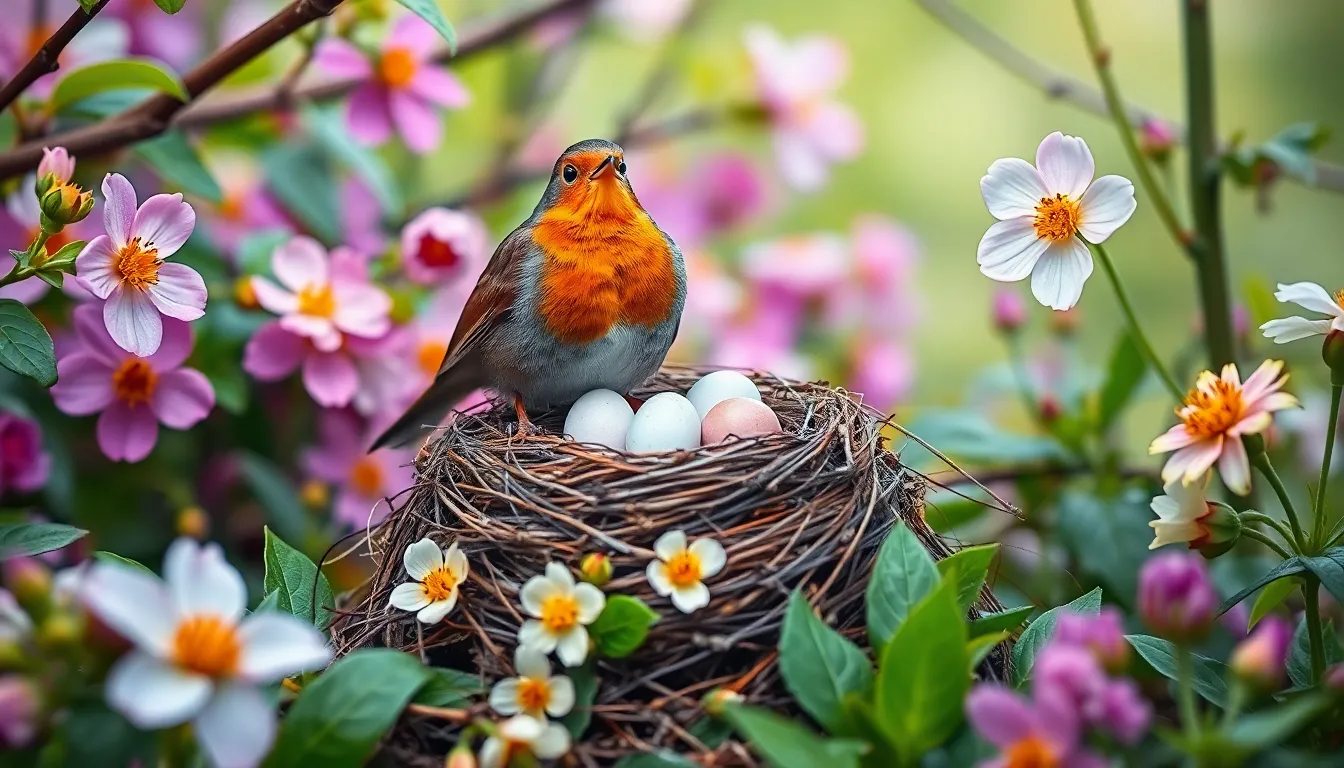
Bird nest construction follows precise seasonal patterns that align with optimal breeding conditions and resource availability. Spring migration triggers the most intensive nest building activity, with temperate region birds typically beginning construction between March and June when temperatures stabilize and food sources become abundant.
Peak Breeding Season Timing
| Bird Species | Primary Nesting Period | Temperature Range (°F) | Daylight Hours |
|---|---|---|---|
| American Robin | March – July | 50-75 | 12-15 hours |
| Northern Cardinal | April – August | 60-80 | 13-16 hours |
| House Sparrow | March – September | 45-85 | 11-17 hours |
| Bald Eagle | February – May | 40-70 | 10-14 hours |
| Barn Swallow | April – August | 55-75 | 13-16 hours |
Temperature fluctuations directly influence nesting schedules across different geographic regions. Northern latitude birds delay nest construction until soil temperatures reach 40°F consistently, while southern species begin as early as February when frost risk diminishes. Mountain dwelling birds wait until snow melts clear potential nesting sites, often resulting in compressed breeding windows of 8-12 weeks compared to lowland species’ 16-20 week seasons.
Photoperiod changes serve as primary environmental cues triggering hormonal responses in breeding birds. Increasing daylight hours stimulate reproductive hormone production, with most species requiring 12+ hours of daylight before initiating nest construction. Arctic breeding birds compress their entire nesting cycle into 6-8 weeks during continuous summer daylight, demonstrating remarkable adaptation to extreme seasonal variations.
Multi-Brood Species Patterns
Secondary nesting periods occur among species that produce multiple broods annually. American Robins construct second nests in July through August, while House Finches may build up to 3 nests between April and September depending on regional climate conditions. These subsequent nests often use different materials and locations as seasonal resource availability changes.
Late season nesters face increased challenges including reduced food availability and approaching migration deadlines. Juvenile birds attempting first-time nesting frequently select suboptimal timing, resulting in lower success rates compared to experienced breeding pairs that synchronize construction with peak insect emergence and fruit production cycles.
Regional climate variations create distinct nesting calendars within the same species across their range. California populations of Anna’s Hummingbirds nest year-round due to mild temperatures and consistent nectar sources, while Colorado populations restrict breeding to May through July when mountain wildflowers bloom.
Human habitat modifications increasingly disrupt traditional seasonal timing patterns. Urban heat islands extend viable nesting periods by 2-4 weeks in metropolitan areas, while agricultural practices alter food availability cycles that historically synchronized with natural breeding seasons.
How to Identify Different Bird Nests
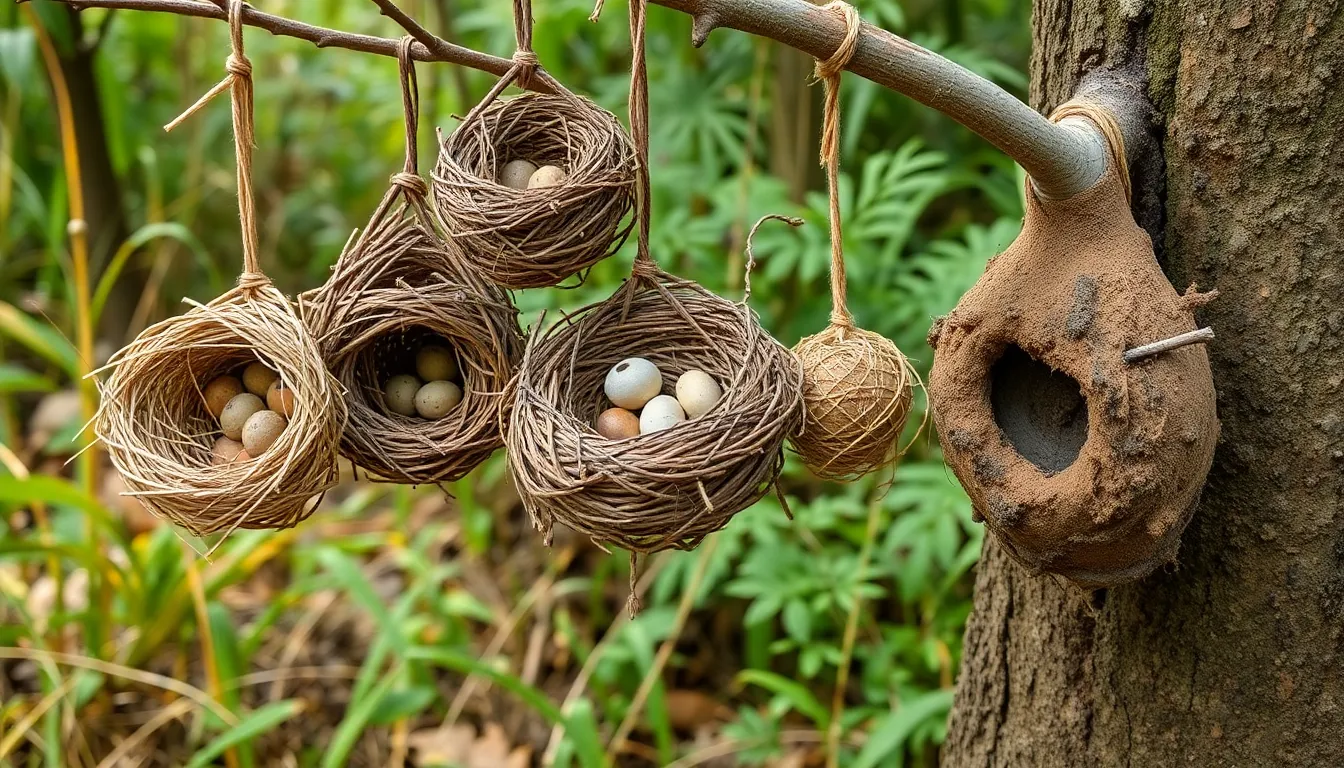
Identifying bird nests requires careful observation of key distinguishing features that reveal the species behind each construction. We can determine the nest builder by examining size, shape, materials, and location patterns that vary significantly across bird families.
Size and Shape Recognition
Cup nests display distinctive bowl shapes with interior diameters ranging from 2-6 inches depending on the species. American Robin nests measure approximately 4 inches across with 2-inch depths while smaller songbirds like wrens create cups measuring just 2.5 inches in diameter. Platform nests appear as flat, broad structures extending 12-36 inches across with minimal depth variations.
Cavity nests present as enclosed chambers within tree trunks or nest boxes with entrance holes sized specifically for each species. Bluebird entrance holes measure 1.5 inches in diameter while larger woodpeckers create openings up to 2.5 inches across. Pendant nests hang like pouches from branch tips measuring 4-8 inches in length with narrow entrance openings at the top.
Material Composition Analysis
Twig construction indicates larger birds such as crows, hawks, and eagles that weave substantial branches into platform foundations. Mud-based nests identify swallows, martins, and robin species that create adobe-like structures against vertical surfaces. Fine grass and plant fiber weaving suggests smaller songbirds including finches, warblers, and sparrows.
Unusual materials provide exact identification clues with Baltimore Orioles incorporating bright orange string and fabric strips into their pendant nests. House Sparrows collect paper scraps and cigarette butts in urban environments while Chimney Swifts cement twigs together using their own saliva.
Location Pattern Recognition
| Nest Location | Typical Species | Height Range | Habitat Preference |
|---|---|---|---|
| Ground level | Killdeer, Meadowlark, Turkey | 0-1 feet | Open fields, shorelines |
| Low shrubs | Cardinals, Mockingbirds | 3-10 feet | Dense vegetation |
| Tree canopy | Eagles, Hawks, Herons | 50-150 feet | Mature forests |
| Tree cavities | Woodpeckers, Owls, Chickadees | 5-40 feet | Dead or dying trees |
| Building structures | Swallows, Martins, Pigeons | 10-200 feet | Urban environments |
Seasonal Timing Indicators
Fresh nest construction during March through May indicates early season breeders including hawks, owls, and crows that begin nesting before foliage emerges. Mid-season builders such as robins, cardinals, and blue jays construct nests during April through June when insect populations peak.
Late season nests appearing in July through August belong to species like goldfinches and cedar waxwings that time reproduction with exact seed availability. Multiple nests in the same territory suggest multi-brood species attempting second or third clutches within a single season.
Species-Exact Identification Features
Oriole nests hang as tightly woven pouches from branch tips using plant fibers and hair with entrance holes positioned at the top. Hummingbird nests appear as tiny cups measuring just 2 inches across decorated with lichen camouflage and lined with soft plant down.
Osprey platforms contain fish bones and seaweed materials indicating aquatic hunting territories while Cooper’s Hawk nests feature prey feathers and bones scattered around the base. Colonial nesters like Purple Martins create apartment-style complexes with multiple entrance holes facing different directions.
Urban vs Natural Nest Adaptations
City-dwelling birds incorporate human-made materials with House Finches using plastic strips and aluminum foil alongside natural fibers. Peregrine Falcons adapt skyscraper ledges that mimic natural cliff faces while maintaining their scrape-style ground nests.
Rural species maintain traditional material preferences with Wood Thrushes using only natural plant fibers and mud while avoiding synthetic alternatives. Suburban environments create hybrid approaches where birds combine natural and artificial materials based on availability and structural requirements.
Bird Nest Safety and Protection Tips
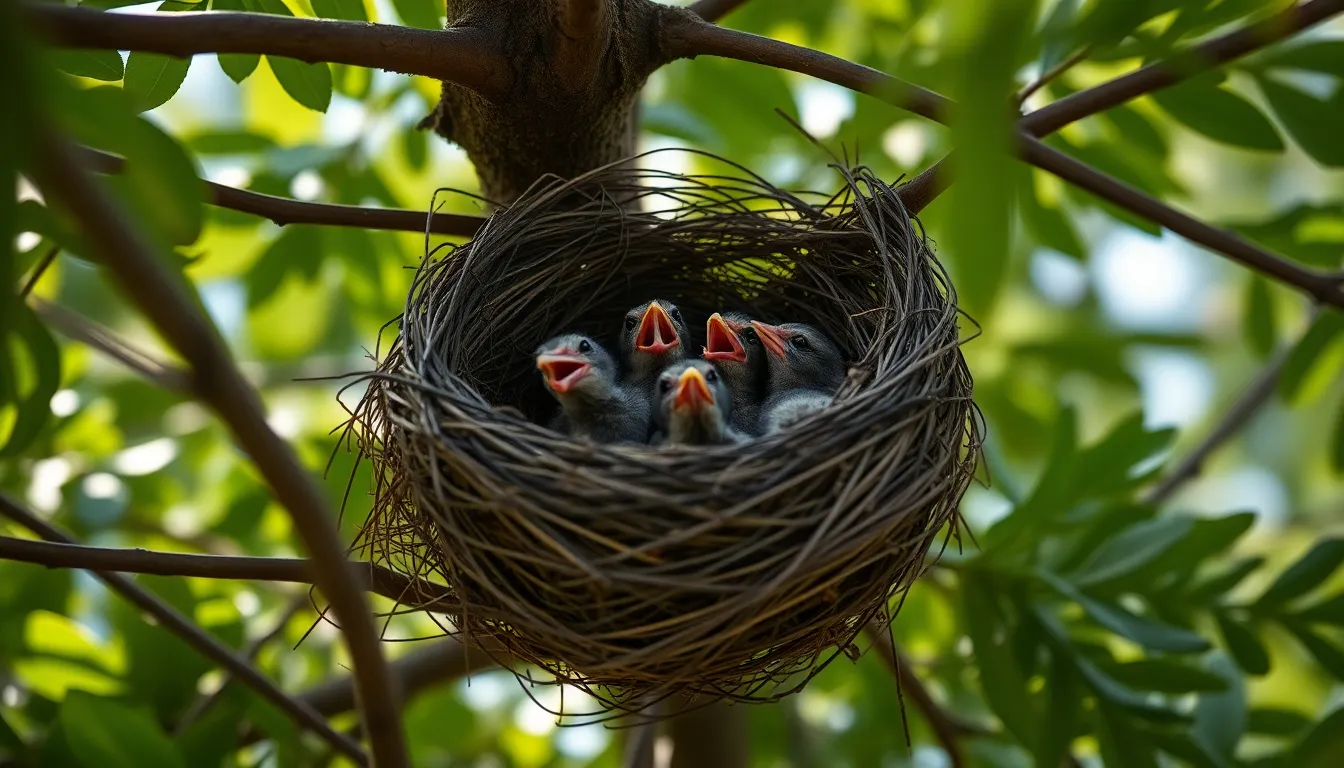
Bird nest protection requires understanding both legal requirements and practical conservation methods. Active bird nests receive strong federal and state protections that make interfering with them illegal in most circumstances.
Legal Protections for Bird Nests
The Migratory Bird Treaty Act of 1918 provides comprehensive protection for over 1,000 bird species and their nests across North America. Federal law prohibits removing active nests containing eggs or young birds without special permits from the U.S. Fish and Wildlife Service. State wildlife agencies enforce additional regulations that often extend protection to inactive nests of certain species.
Native bird species receive automatic protection under federal statutes regardless of property ownership. Violations can result in fines up to $15,000 per nest and potential criminal charges for repeat offenses. European Starlings, House Sparrows, and Rock Pigeons represent the primary exceptions as non-native species without federal protection.
Property owners must wait until nesting activity concludes before removing old nests from buildings or structures. Timing varies by species but generally occurs between late summer and early fall when young birds have fledged. Documentation through photographs helps establish nest abandonment before any removal activities begin.
How to Help Nesting Birds
Creating bird-friendly environments supports successful nesting through habitat enhancement and disturbance reduction. Maintain natural vegetation within 15-20 feet of identified nesting sites to provide cover and foraging opportunities during the breeding season.
Install predator guards on poles supporting nest boxes at heights between 5-6 feet above ground level. Baffle designs prevent climbing predators like cats and raccoons from accessing nests while allowing parent birds easy entry. Check nest boxes monthly during non-breeding seasons to remove old materials and perform maintenance.
Provide fresh water sources within 100 feet of nesting areas using shallow dishes or dripping features that attract birds without creating drowning hazards. Clean water containers every 2-3 days during warm weather to prevent mosquito breeding and disease transmission.
Minimize yard work activities between March and August when most species construct nests and raise young. Schedule tree trimming and landscaping projects for fall or winter months to avoid disturbing active breeding pairs. Keep cats indoors during nesting season as outdoor cats kill approximately 2.4 billion birds annually in North America.
Avoid using pesticides and herbicides within 50 feet of known nesting sites as chemical treatments reduce insect populations that serve as primary food sources for nestlings. Organic gardening methods support healthy ecosystems that benefit both adult birds and their developing offspring.
Common Bird Nest Problems and Solutions
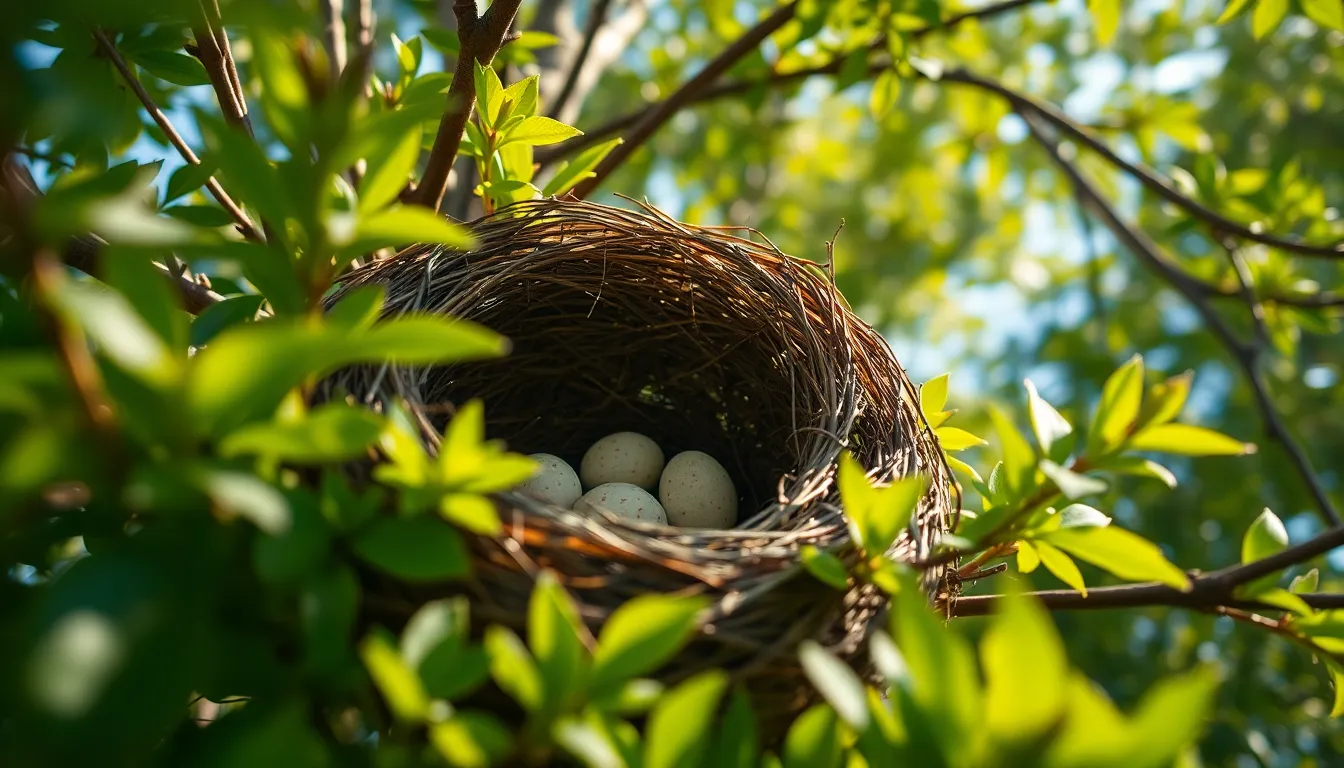
Bird nest construction faces many challenges that threaten reproductive success across species. Predation remains the most important threat, with studies showing that 40-80% of songbird nests experience predation during the breeding season. Weather extremes destroy approximately 15-25% of active nests annually, while habitat loss eliminates suitable nesting sites for millions of birds each year.
Predator-Related Issues
Cats kill 1.3-4 billion birds annually in North America alone, making them the primary predator threat to nesting birds. Domestic cats access ground nests and low-hanging branches with ease, particularly targeting species like American Robins and Song Sparrows. Snakes climb trees to reach cup nests, while raccoons use their dexterous paws to extract eggs and nestlings from cavity nests.
Effective Predator Answers:
- Install predator guards on nest boxes and poles using cone-shaped metal barriers
- Position nesting structures 50+ feet from buildings where cats congregate
- Create dense shrub plantings around nest sites to provide multiple escape routes
- Mount nest boxes on smooth metal poles at least 5 feet high
- Keep domestic cats indoors during peak nesting season (March through August)
Weather and Environmental Challenges
Heavy rainfall floods ground nests and saturates tree cavities, causing hypothermia in young birds. Wind storms destroy platform nests built by hawks and eagles, with gusts exceeding 30 mph toppling inadequately anchored structures. Temperature extremes above 95°F or below 50°F during incubation periods result in embryo death rates reaching 60-70%.
Weather Protection Strategies:
- Plant evergreen trees and dense shrubs to create natural windbreaks
- Install drainage systems around ground-level nesting areas
- Provide covered shelter structures with 2-3 inch entrance holes
- Position nest boxes facing southeast to minimize exposure to prevailing winds
- Create layered vegetation canopies to buffer temperature fluctuations
Human Interference Problems
Construction activities during nesting season displace breeding pairs and destroy active nests. Landscaping practices remove native plants that provide essential nesting materials like spider webs, moss, and soft grasses. Light pollution disrupts nocturnal birds’ natural nesting cycles, while noise levels above 60 decibels cause nest abandonment in sensitive species.
Human Impact Answers:
- Schedule major construction projects outside breeding season (September through February)
- Maintain native plant gardens with materials like milkweed fluff and dried grasses
- Install motion-activated lighting instead of constant illumination
- Reduce lawn mowing frequency during peak nesting months
- Create buffer zones of 100+ feet around known nesting sites
Nesting Material Scarcity
Urban environments lack natural nesting materials, forcing birds to use inappropriate substitutes like plastic strips and cigarette butts. Deforestation removes lichen and moss sources essential for hummingbird nest construction. Pesticide applications eliminate spider populations, reducing available silk for nest binding in over 30 songbird species.
| Material Type | Natural Source | Urban Alternative | Success Rate |
|---|---|---|---|
| Soft lining | Animal fur, down | Cotton batting, yarn scraps | 85% |
| Binding material | Spider silk | Thin wire, string | 70% |
| Structural base | Twigs, stems | Plastic strips, wire | 60% |
| Insulation | Moss, lichen | Paper scraps, fabric | 75% |
Material Availability Answers:
- Provide natural nesting material stations with cotton, hemp fiber, and dried grasses
- Avoid pesticide applications within 200 feet of nesting areas
- Leave brush piles and fallen branches for material collection
- Plant native species that produce suitable nesting materials
- Install specialized nesting material dispensers near bird feeding areas
Cavity Nest Competition
European Starlings and House Sparrows aggressively compete for nest cavities, displacing native species like Eastern Bluebirds and Tree Swallows. These invasive species arrive earlier in spring and claim prime nesting sites before native birds complete migration. Competition intensity increases in areas with limited natural tree cavities.
Competition Management Answers:
- Install species-exact nest boxes with appropriate entrance hole sizes (1.5 inches for bluebirds)
- Space multiple nest boxes 100+ yards apart to reduce territorial conflicts
- Remove invasive species nests before egg laying begins
- Provide abundant nesting options to exceed demand by 25-30%
- Monitor nest box usage weekly during breeding season
Structural Failures
Platform nests built by herons and egrets collapse when supporting branches cannot bear increasing weight as chicks grow. Cavity nests in dead trees become vulnerable to wind damage and branch breakage. Cup nests constructed with insufficient binding materials fall apart during storms, losing entire broods.
- Prune dead branches that threaten nest stability during winter months
- Install artificial platforms for large bird species using treated lumber
- Provide supplemental nesting materials early in construction phase
- Create multiple nesting sites to allow rebuilding after failures
- Maintain healthy tree populations through proper pruning and disease management
The Ecological Importance of Bird Nests

Bird nests function as fundamental components in maintaining healthy ecosystems across diverse habitats. These architectural marvels create cascading effects that extend far beyond individual species, influencing biodiversity patterns and network stability throughout natural environments.
Habitat Creation and Biodiversity Support
Abandoned bird nests provide shelter for many secondary species including mammals, reptiles, and insects. Squirrels commonly repurpose old crow nests and raptor platforms for winter dens, while cavity nests created by woodpeckers become essential homes for over 80 North American bird species. Large platform nests constructed by eagles and ospreys often accommodate smaller birds like house sparrows and tree swallows as secondary tenants, creating multi-species nesting communities.
Decomposing nest materials enrich soil composition with organic matter and nutrients. Research indicates that areas beneath large colonial nesting sites show 40% higher nitrogen levels compared to surrounding soils, creating localized fertility zones that support diverse plant communities.
Seed Dispersal and Plant Propagation
Nesting birds transport plant materials across important distances, facilitating seed dispersal patterns that maintain genetic diversity in plant populations. Studies document that American Robins carry nesting materials up to 2 miles from collection sites, inadvertently dispersing seeds embedded in moss, bark, and plant fibers used in nest construction.
Colonial nesters create particularly effective seed dispersal networks. Cliff swallow colonies can transport thousands of seeds annually through mud pellets collected from various wetland locations, establishing new plant communities in previously barren cliff face environments.
Pollination Networks
Ground nesting birds contribute to pollination cycles by disturbing vegetation during nest construction and maintenance activities. Prairie species like bobolinks and meadowlarks create small clearings that promote wildflower growth, supporting native pollinator populations including bees, butterflies, and hummingbirds.
Cavity nesting birds indirectly support pollination by maintaining healthy tree populations. Woodpecker excavations improve tree health by removing diseased wood sections, ensuring flowering tree survival that sustains broader pollinator communities.
Pest Control Integration
Active nests serve as central hubs for intensive pest control activities throughout breeding territories. Parent birds consume exponentially higher quantities of insects during chick-rearing phases, with a single chickadee pair eliminating over 570 caterpillars per day from surrounding vegetation.
Colonial nesting sites amplify these pest control benefits across industry scales. Purple martin colonies containing 50+ pairs can consume 15,000 mosquitoes daily within a 2-mile radius, creating important pest suppression zones that benefit both wildlife and human communities.
Nutrient Cycling Acceleration
Nest sites concentrate nutrient deposition through accumulated droppings, eggshell fragments, and decomposed organic materials. These nutrient hotspots create microhabitats with enhanced soil fertility that support specialized plant communities and soil organisms.
Marine bird nesting colonies transfer oceanic nutrients to terrestrial ecosystems through guano deposits. Seabird colonies can deposit 25-50 tons of nitrogen-rich fertilizer per hectare annually, creating uniquely productive ecosystems that support endemic plant species and diverse invertebrate communities.
Climate Regulation Contributions
Dense nesting habitats contribute to local climate moderation through increased vegetation growth and moisture retention. Riparian nesting areas support 60% more vegetation cover compared to non-nesting zones, creating cooler microclimates and reducing temperature fluctuations by up to 8 degrees Fahrenheit.
Forest canopy nesters promote tree health and longevity by controlling insect pest populations, maintaining carbon sequestration capacity across woodland ecosystems. Research demonstrates that areas with active bird nesting show 23% better tree survival rates during drought conditions.
Conclusion
Bird nests represent one of nature’s most remarkable architectural achievements showcasing millions of years of evolutionary refinement. We’ve explored how these intricate structures serve far beyond simple shelters – they’re sophisticated systems that support entire ecosystems and demonstrate the incredible adaptability of avian species.
Understanding bird nesting behaviors helps us appreciate the delicate balance required for successful reproduction and network health. From the materials they choose to the timing of construction every aspect reflects nature’s precision and ingenuity.
As stewards of our environment we play a crucial role in protecting these natural masterpieces. By creating bird-friendly spaces and respecting nesting sites we ensure future generations can witness the amazing industry of bird nest construction and the vital ecological functions they provide.
Frequently Asked Questions
What is a bird nest and why do birds build them?
A bird nest is a carefully constructed shelter designed for laying eggs, incubating them, and raising young birds. Birds build nests to protect their offspring from predators and environmental hazards, provide insulation from harsh weather conditions, offer structural support for eggs and chicks, and establish territorial boundaries. The construction process is primarily driven by hormonal changes during breeding season and the instinctual need for reproductive success.
What are the different types of bird nests?
There are four primary types of bird nests: cup nests (bowl-shaped structures built by songbirds), platform nests (flat, stable foundations used by larger birds like eagles), cavity nests (enclosed spaces in tree holes or nest boxes used by woodpeckers and owls), and ground nests (simple depressions created by species like killdeer that rely on camouflage for protection).
What materials do birds use to build their nests?
Birds use a variety of natural and human-made materials including twigs, plant fibers, mud, moss, feathers, animal hair, and soft grasses for lining. Urban birds have adapted to incorporate human-made items like string, paper, and fabric scraps. The choice of materials depends on the species, location, and availability, with birds often combining multiple materials for optimal structural integrity.
When do birds typically build their nests?
Most birds build nests during spring, aligning with optimal breeding conditions and resource availability. Construction timing varies by species: early nesters begin in February-March, mid-season builders work during April-May, and late nesters construct homes in June-July. Some species like American Robins may build multiple nests per season, while regional climate variations create distinct nesting calendars.
How can I identify different bird nests?
Bird nests can be identified by examining size, shape, materials, and location. Small cup nests (3-5 inches) belong to songbirds, while large platform nests indicate raptors. Material clues include mud construction (swallows), stick platforms (crows), and woven grass (finches). Location patterns also help: ground level suggests quail or meadowlarks, while high tree placement indicates eagles or hawks.
Is it legal to remove or disturb bird nests?
Under the Migratory Bird Treaty Act of 1918, it’s illegal to disturb, damage, or remove active nests of protected bird species without special permits. Property owners should wait until nesting activity concludes naturally before removing old, abandoned nests. Violations can result in significant fines and legal penalties, making it essential to verify nesting status before taking any action.
How can I protect bird nests in my yard?
Create bird-friendly environments by maintaining natural vegetation, installing predator guards around nest sites, providing fresh water sources, and minimizing yard work during nesting season (March-August). Keep cats indoors, avoid using pesticides near nesting areas, plant dense shrubs for cover, and schedule major construction projects outside breeding season to reduce disturbance to nesting birds.
What challenges do bird nests face?
Bird nests face multiple threats including predation (especially from domestic cats), severe weather conditions, habitat loss, human interference, and competition from invasive species. Urban environments present additional challenges like nesting material scarcity and increased noise pollution. Climate change also affects traditional nesting timing and success rates, requiring birds to adapt their breeding strategies continuously.
Why are bird nests important for ecosystems?
Bird nests play crucial roles in ecosystem health by supporting biodiversity, facilitating seed dispersal, and contributing to nutrient cycling. Abandoned nests provide shelter for secondary species, while active nests serve as hubs for insect consumption and pest control. Nesting birds also contribute to pollination networks and help maintain soil composition, creating cascading ecological benefits for entire ecosystems.
Where do birds prefer to build their nests?
Birds choose nesting locations based on protection from predators, favorable environmental conditions, and resource availability. Songbirds typically nest 3-12 feet above ground, while raptors prefer heights of 50-150 feet. Forest species favor locations with multiple escape routes, wetland birds nest near water sources, and ground-nesters select open areas with clear sightlines for predator detection.

